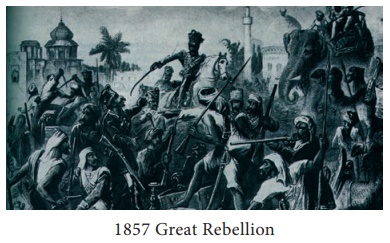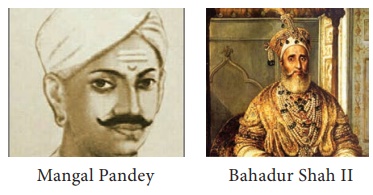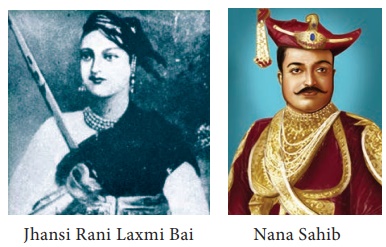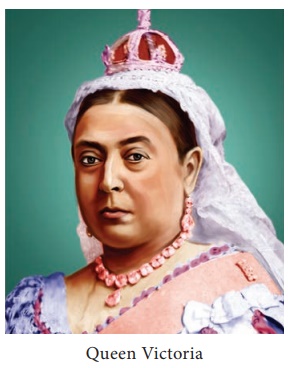Early Resistance to British Rule - Great Rebellion 1857 | 11th History : Chapter 18 : Early Resistance to British Rule
Chapter: 11th History : Chapter 18 : Early Resistance to British Rule
Great Rebellion 1857
Great Rebellion 1857
Introduction
1857 has been a subject of much debate among
historians, both British and Indian. British imperialist historians dismissed
it a mutiny, an outbreak among soldiers. Indian historians who explored the
role of the people in converting a military outbreak into a rebellion raised
two questions to which the imperial historians have had no answer. If it was
only a military outbreak how to explain the revolt of the people even before
the sepoys at those stations mutinied? Why was it necessary to punish the
people with fine and hanging for complicity in acts of rebellion? Col.
Mallesan, the Adjutant General of the Bengal army in a pamphlet titled The Making of the Bengal Army remarked, ‘a military mutiny...speedily changed its character and became a national
insurrection’.
The historian Keene attributed the outbreak due to
operation of variety of factors: to the grievances of princes, soldiers and the
people, produced largely by the annexation and reforming zeal of Dalhousie. The
greased cartridge affair merely ignited the combustible matter which had
already accumulated. Edward John Thompson described the event ‘as largely a
real war of independence’. V.D. Savarkar, in his The War of Indian Independence,
published in 1909, argued that what
the British had till then described as merely mutiny was, in fact, a war of
independence, much like the American War of Independence. Despite the fact that
the English-educated middle class played no role in the rebellion, nationalist
historians championed this argument as the First War of Indian Independence.
Causes of the Rebellion

Territorial Aggrandisement
The annexation of Oudh and Jhansi by Dalhousie
employing the Doctrine of Lapse and the humiliating treatment meted out to Nana
Sahib, the last Peshwa’s adopted son produced much dissatisfaction. In the wake
of the Inam Commission (1852) appointed by Bombay government to enquire into the
cases of “land held rent-free without authority,” more than 21,000 estates were
confiscated. The land settlement in the annexed territories, particularly in
Oudh, adversely affected the interests of the talukdars, who turned against the
British. Moreover, in Oudh, thousands of inhabitants who depended on the royal
patronage and traders who were dealing in rich dresses and highly ornamented
footwear and expensive jewellery lost their livelihood. Thus Dalhousie through
his expansionist policy created hardship to a number of people.
Oppressive Land Revenue System
The rate of land revenue was heavy when compared
with former settlements. Prior to the British, Indian rulers collected revenue
only when land was cultivated. The British treated land revenue as a rent and
not a tax. This meant that revenue was extracted whether the land was
cultivated or not, and at the same rate. The prices of agricultural commodities
continued to crash throughout the first half of nineteenth century and in the
absence of any remission or relief from the colonial state, small and marginal
farmers as well as cultivating tenants were subject to untold misery.
Alienation of Muslim Aristocracy
and Intelligentsia
Muslims depended largely on public service. Before
the Company’s rule, they had filled the most honourable posts in former
governments. As commandants of cavalry some of them received high incomes. But
under the Company’s administration, they suffered. English language and western
education pushed the Muslim intelligentsia into insignificance. The abolition
of Persian language in the law courts and admission into public service by
examination decreased the Muslim’s chances of official employment.
Religious Sentiments
The Act of 1856 providing for enrolment of high
caste men as sepoys in the Bengal army stipulated that future recruits give up
martial careers or their caste scruples. This apart, acts such as the abolition
of sati, legalization of remarriage of Hindu widows, prohibition of infanticide
were viewed as interference in religious beliefs. In 1850, to the repugnance of
orthodox Hindus, the Lex Loci Act was passed permitting converts to
Christianity to retain their patrimony (right to inherit property from parents
or ancestors).
Further the religious sentiments of the sepoys –
Hindus and Muslims – were outraged when information spread that the fat of cows
and pigs was used in the greased cartridges. The Indian sepoys were to bite
them before loading the new Enfield rifle. This was viewed as a measure to
convert people to Christianity.
In every sense, therefore, 1857 was a climatic
year. The cartridge affair turned out to be a trigger factor for the rebellion.
The dispossessed, discontented rajas, ranis, zamindars and tenants, artisans
and workers, the Muslim intelligentsia, priests, and the Hindu pandits saw the
eruption as an opportunity to redress their grievances.
Course of the Revolt
The rebellion first began as a mutiny in
Barrackpore (near Calcutta). Mangal Pandey murdered his officer in January 1857
and a mutiny broke out there. In the following month, at Meerut, of the 90
sepoys who were to receive their cartridges only five obeyed orders. On 10 May
three sepoy regiments revolted, killed their officers, and released those who
had been imprisoned. The next day they reached Delhi, murdered Europeans, and
seized that city. The rebels proclaimed Bahadur Shah II as emperor.

By June the revolt had spread to Rohilkhand, where
the whole countryside was in rebellion. Khan Bahadur Khan proclaimed himself
the viceroy of the Emperor of India. Nearly all of Bundelkhand and the entire
Doab region were up in arms against the British. At Jhansi, Europeans were
massacred and Laxmi Bai, aged 22, was enthroned. In Kanpur Nana Sahib led the
rebels. About 125 English women and their children along with English officers
were killed and their bodies were thrown into a well. Termed as the Kanpur
massacre, this incident angered the British and General Henry Havelock, who was
sent to deal with the situation, defeated Nana Sahib the day after the
massacre. Neill, who was left there, took terrible vengeance and those whom he
regarded as guilty were executed. Towards the close of November Tantia Topi
seized Kanpur but it was soon recovered by Campbell.

The Lucknow residency, defended by Henry Lawrence
fell into the hands of rebels. Havelock marched towards Lucknow after defeating
Nana Sahib, but he had to retire. By the close of July John Nicholson sent by
John Lawrence to capture Delhi succeeded in capturing Delhi. The Mughal emperor
Bahadur Shah II now became a prisoner and his two sons and grandson were shot
dead after their surrender.
Resistance in Oudh was prolonged because of the involvement of talukdars as well as peasants in the revolt. Many of these taluqdars were loyal to the Nawab of Awadh, and they joined Begum Hazrat Mahal (the wife of the NawabWajid Ali Shah) in Lucknow to fight the British. Since a vast majority of the sepoys were from peasant families in the villages of Oudh, the grievances of the peasants had affected them. Oudh was the nursery of the Bengal Army for a long time. The sepoys from Oudh complained of low levels of pay and the difficulty of getting leave. They all rallied behind Begum Hazrat Mahal. Led by Raja Jailal Singh, they fought against the British forces and seized control of Lucknow and she declared her son, Birjis Qadra, as the ruler (Wali) of Oudh. Neill who wreaked terrible vengeance in Kanpur was shot dead in the street fighting at Lucknow. Lucknow could be finally captured only in March 1858.
Neill’s statue on the Mount Road,
Madras angered the Indian nationalists. The Congress Ministry of Rajaji
(1937-39) removed it and lodged it in the Madras Museum.
Hugh Rose besieged Jhansi and defeated Tantia Topi
early in April. Yet Lakshmi Bai audaciously captured Gwalior forcing
pro-British Scindia to flee. Rose with his army directly confronted Lakshmi
Bai. In this battle Lakshmi Bai died fighting admirably. Rose described Lakshmi
Bai as the best and bravest military leader of the rebels.
Gwalior was recaptured soon. In July 1858 Canning
announced the suppression of the “Mutiny” and restoration of peace. Tantia Topi
was captured and executed in April 1859.
Bahadur Shah II, captured in September 1857, was
tried and declared guilty. He was exiled to Rangoon (Myanmar), where he died in
November 1862 at the age of 87. With his death the Mughal dynasty came to an
end.
Effects of the Great Rebellion
Queen’s Proclamation 1858
A Royal Durbar was held at Allahabad on November 1,
1858. The proclamation issued by Queen Victoria was read at the Durbar by Lord
Canning, who was the last Governor General and the first Viceroy of India.

·
Hereafter India would be governed by and in the name of the British Monarch through a Secretary of
State. The Secretary of State was to be assisted by a Council of India
consisting of fifteen members. As a result, the Court of Directors and the
Board of Control of the East India Company were abolished and the Crown and
Parliament became constitutionally responsible for the governance of India. The
separate army of the East India Company was abolished and merged with that of
Crown.
·
Proclamation endorsed the treaties made by the Company with Indian princes, promised to respect their
rights, dignity and honour, and disavowed any ambition to extend the existing
British possessions in India.
·
The new council of 1861 was to have Indian nomination, since the Parliament thought the Legislative
Council of 1853 consisted of only Europeans who had never bothered to consult
Indian opinion and that led to the crisis.
·
The Doctrine of Lapse and the policy of annexation to be given up. A general amnesty (pardon) to be
granted to the rebels except those who directly involved in killing the British
subjects.
·
The educational and public works programmes (roads, railways, telegraphs, and irrigation) were
stimulated by the realization of their value for the movement of troops in
times of emergency.
·
Hopes of are vival of the past
diminished and the traditional structure of Indian society began to break
down. A Westernized English-educated middle class soon emerged with a
heightened sense of nationalism.
Related Topics